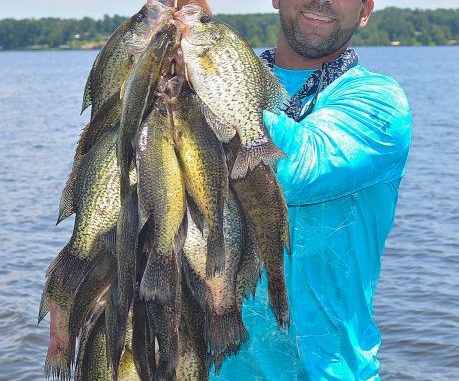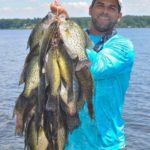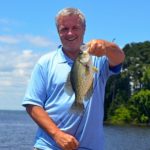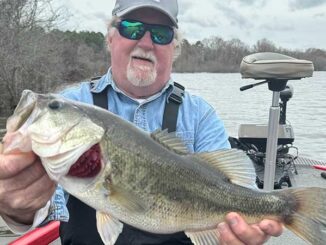
Although double-digit bass are all the rage at Toledo Bend, the huge reservoir is loaded with crappie. Here are locations, tips and tactics that will yield hefty limits of summer slabs.
It was the day of the full moon of May 2015, and New Iberia’s Shane Johnson was pumped.
“This trip could not have worked out better with timing,” the 43-year-old Toledo Bend guide said.
Sharing Johnson’s pontoon boat were Joel Berzas and the father-son team of Tom and Brandon Schueller.
Johnson motored the few miles from his Lanan camp south to Pendleton Bridge. Situated below each of the structure’s twin pilings are sections of a public artificial reef, each of which consist of 20 feed pallet trees.
Upon arrival, Johnson inspected his Lowrance and pointed out immense clouds of schooling fish around and atop the structure.
“Yep, the baitfish are here,” he said. “Let’s get fishing.”
Johnson had light spincast tackle ready, and the anglers began hooking small- to medium-sized shiners on 2/0 golden Aberdeen hooks.
The guide had all lines preset with small knots tied 14 feet above the jigs so the anglers would know how deep to fish.
“That’s the depth we are catching them,” Johnson said.
When the lines were dropped and stopped at the knot, taps began immediately and slab crappie started piling into the boat.
“We catch a few throwbacks, but right now it’s hard to catch anything under 10 inches,” said Johnson of Acadian Outdoor Charters (337-519-2049).
The cooler was steady filling with more crappie, with Johnson clicking his mechanical counter every time a fish was thrown in.
The Toledo Bend daily creel limit is 25 crappie per angler.
At 10 a.m., Johnson moved the boat closer to the Sabine River channel, and the anglers fished another set of reefs near pilings 24 and 25.
More crappie, along with a few white bass, were quickly snatched into the boat.
Once the area played out, Johnson made a quick trip north of the bridge to the edge of the channel in open waters.
“It’s a little early for fishing here, but let’s see if we can finish out some limits,” he said.
On the far edges of the points in 18 feet of water, the anglers began working a series of brush piles Johnson had set out earlier in the spring.
The fish were there and ready to eat.
By the trip’s end, the anglers limited out on crappie.
Most impressive were the sizes of the fillets: These were crappie ranging from just under half a pound to 1½ pounds.
“My hometown friends always wondered why I prefer fishing for Toledo Bend sac-a-lait when I have the Atchafalaya Basin not far from my home in New Iberia,” Johnson said. “Let me tell you: There is no comparison to the consistent numbers and sizes of sac-a-lait found in Toledo Bend on any given day in the summer.”
That fact isn’t exactly a secret. From May through the summer there’s a continuous migration of Louisiana and Texas crappie anglers to this border lake.
“Hands down, that’s because Toledo Bend is No. 1 for delivering so many big crappie,” Johnson said. “They may not be reported like the 3½-pounders taken at Poverty Point Reservoir during the spawn this year — but those sizes are here.”
A review of the Toledo Bend Lake records as published by the Lakecaster magazine revealed that the largest black crappie on record was a 4-pounder taken in 2002 by Hazel Bolton.
The records also showed the top Toledo Bend white crappie weighed 3.44 pounds. It was taken on rod and reel in 2011 by Claude Gilcrease Jr.
“I don’t know of any other lake in Louisiana that produces both the high quantity and high quality of sac-a-lait that Toledo Bend does,” Johnson said. “And this continues for three solid months on a daily basis, when the weather cooperates.
“It is not uncommon to catch fish over 2 pounds once or twice a week.”
Local anglers have taken this for granted, and some of the larger fish are just not reported.
“There is just no other location in Louisiana where an angler can catch a limit of 25 fish where the average is a solid pound,” Johnson said. “It’s just great fishing.”
That contention is more than just anecdote. And the health of the fishery can be traced back to the low-water years of the recent past.
“It’s a very healthy crappie fishery we have at Toledo Bend,” LDWF fisheries biologist Jason Brancamp said. “We have had evidence of good recruitment in recent years.
“Absolutely there has also been an increase in size based on the forage availability. Those drought years exposed the lake beds and upon re-flooding back to pool stage there was just so much new cover and forage for baitfish, crappie and bass.”
As a result, gamefish populations exploded.
The lake holds white and black crappie, but you’re much more likely to catch numbers of the latter.
“Black crappie make up 80 to 85 percent of the crappie population any given year on the Bend,” LDWF biologist Sean Kinney said.
Johnson said white crappie tend to appear later at the bridge and brush piles than their darker brethren.
“White crappie will be heavier but produce less flesh for fillets,” he said. “The whites have a thicker backbone and a higher percentage of bone mass.
“When you compare a 2-pound white (crappie) versus a black at 2 pounds, the black crappie will give you more flesh than the white.”




